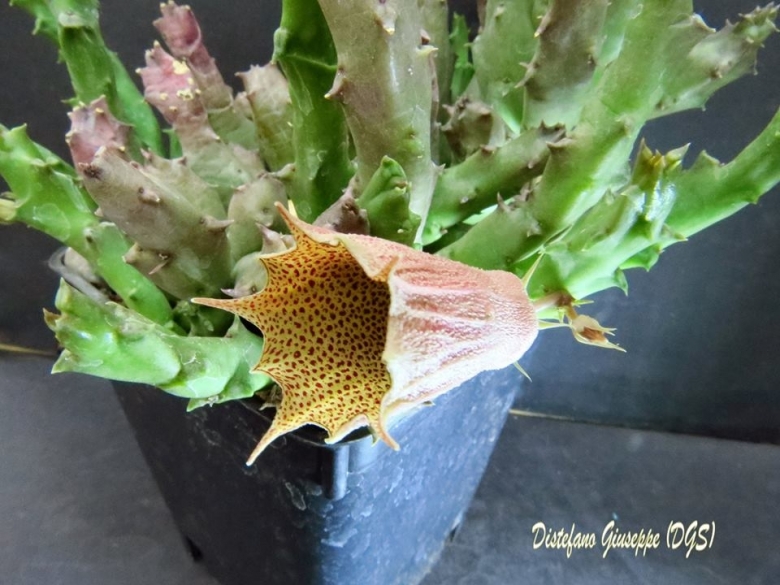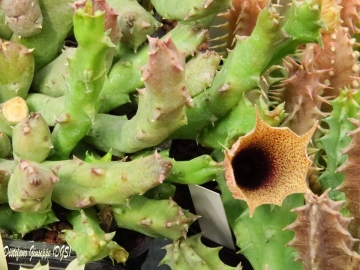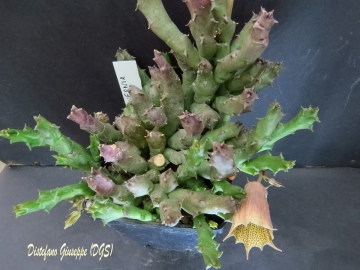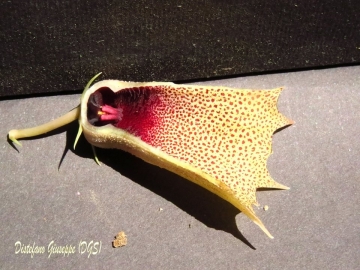




Your support is critical to our success.

Origin and Habitat: Botswana, Zambia and Zimbabwe
Synonyms:
- Huernia levyi Oberm.
Description: Huernia levyiSN|30463]]SN|33111]] forms fleshy small clumps with greyish green stems branching near the base. The stems nearly erect 4 angled. The flower is instantly recognisable and cannot be mistaken for that of any other species. It is strikingly elongated 8up to 4 cm long), 5 lobed with rough exteriors, cream to yellow coloured, and heavily speckled with burgundy. The lobes are short and flared outwards. This flower form might be said to be an exaggerated form of the flower of Huernia keniensisSN|30716]]SN|25788]], which also shares, the roughly papillous exterior of the reddish tube lined with raised nerves. The stems are nearly erect, 4-5 angled, finger-like about 7 cm long and armed with prominent teeth.
Derivation of specific name: The name of this species should be an object lesson for those who name plants. In 1909 . N.E. Brown described a new Huernia with a flower tube considerably longer than any species then known as Huernia longitubaSN|33111]]SN|30716]]. Inevitably, some years later a plant was discovered in north-west Zimbabwe with a flower tube twice the length of that of H. longituba. The most appropriate name being unavailable, it was named H. levyi for its discoverer in Flowering Plants of South Africa, 1936.
(Description by Miss A. A. Obermeijer 1936):
Stems: erect, 7 cm. high and 3.5 cm. thick including the teeth, 4 to 5-angled and deeply grooved between the angles; teeth 1 cm. long, triangular, acute.
Leaf rudiments: Narrow-ovate, 2 mm. long, deciduous.
Flowers: 1 to 3 together at the base of the stems, developing successively; Pedicel: 8 mm. long; Calyx: 6 mm. long; sepals narrow-ovate, acuminate; Corolla: tubular, 3.5 cm. long; tube cylindrical, 3 cm. long, 1.2 cm. in diameter near the base, 1.7 cm. in diameter at the apex, gradually passing into 5 short triangular acuminate lobes, which slightly curve outwards; sinuses acute, somewhat recurved ; outer surface of entire corolla scabrous, mottled reddish-purple; inside base of tube velvety, dark maroon, with a raised annulus 5 mm. above the base, densely covered with small conical papillae, the part above the annulus densely covered with elongate conical papillae, 1 mm. long, which bear 1 to 2 setae, 1 to 1.5 mm. long; towards the mouth of the tube and on the lobes the papillae diminish in size, the setae disappear, while the color changes from dark maroon to creamy-yellow spotted with red ; Outer corona: flatly conical, circular at the base; ; Inner corona: lobes 3 mm. long, geniculate at the base, with 5 finger-like processes somewhat in- flexed over the staminal column; tips slightly recurved, tuberculate, tinged with maroon.
Related species: Huernia levyiSN|30716]]SN|33111]] has the longest tube in the genus, considerably exceeding that of the related Huernia longitubaSN|25788]]SN|30716]]. H levyi appears to be most closely related to Huernia hislopiiSN|33111]]SN|30463]] subsp. robusta which also occurs in the same general geographical area with a slight distributional overlap. However, with its long tubular corolla and unique corona this most distinctive species may be instantly distinguished from both these relatives.
Bibliography: Major references and further lectures
1) Alain Campbell White, Boyd L. Sloane “The Stapelieae”, Volume 3 Typography and printing by S. E. Haselton at Abbey San Encino Press, 1937
2) A. A. Obermeijer: “The Flowering Plants of Africa”, Volume 16 t. 616 1936. Botanica. Research Institute, Department of Agricultural Technical Services, Republic of South Africa., 1936
3) Werner Rauh “The Wonderful World of Succulents: Cultivation and Description of Selected Succulent Plants Other Than Cacti” Smithsonian Institution Press, 1984
4) Huernia levyi: British Cactus & Succulent Journal, Cactus & Succulent Society, 1983
5) L. C. Leach “A Revision of Huernia R. Br. (Asclepiadaceae)” Aloe, Cactus and Succulent Society of Zimbabwe, 1988
6)Focke Albers, Ulrich Meve “Illustrated Handbook of Succulent Plants: Asclepiadaceae: Asclepiadaceae” Volume 4 Springer, 2002

Huernia levyi Photo by: Giuseppe Distefano

Huernia levyi Photo by: Giuseppe Distefano

Huernia levyi Photo by: Giuseppe Distefano

Huernia levyi Photo by: Giuseppe Distefano
Cultivation and Propagation: Huernia levyiSN|33111]]SN|33111]] isn't difficult to grow and flower but needs more water than most other species.
Spring: When winter ends and they begin to grow again, they will require much water and soaking the pots will no longer put the plants at risk for rot. In the spring they will grow well in partial shade and leaving them out in the rain may provide them with the water they need.
Summer: In the summer months they will tolerate heavy rain, but will be just as happy if the season is dry. It's best to sort out the stems while the plants are resting in the summer before they begin their autumnal growth cycle. They will tolerate very hot weather outdoors as long as they are kept in filtered light and this will encourage them to flower in the Autumn. They also enjoy some fertiliser. Moving the plants as they are developing buds may cause them to spontaneously abort the flowers all together.
Autumn: In the fall keep them outdoors until the night time temperatures drop below the 10°C.
Winter: Winter care presents no problems at 10° C with plenty of light. As soon as they are flowered be sure to take extra precautions to keep them dry, because damp cool conditions when the plants are resting is an invitation to fungal infections, but - according to temperatures –some occasional lit watering may be useful.
Potting medium: Since roots are quite shallow, use a cactus mix or add extra perlite or pumice to regular soil potting soil. A gritty, very free-draining compost is suitable, and clay pots help the plants to dry out between watering. Re-pot every 2 years.
Pest and diseases: Huernia are generally fairly easy to grow, especially if kept pest-free. They are very susceptible to stem and root mealy bugs, and damage from these may well initiate fungal attack. Any time when there is a dead or dying stem in the pot it is important to remove it immediately and completely before other healthy stems can become ill too, isolate the healthy parts, dry them off, and re-root them in new compost.
Propagation: Easiest with stem cuttings. Allow cuttings to dry a day before planting. Stems must be laid (Not buried) on gritty compost and will then root from the underside of the stems. It can also be increased from seeds sowing in spring in moist, sandy peat moss. Barely cover seeds. Seeds germinate quickly.
In any season it's best to lay the stems out for several days before replanting them and then pot them only in dry soil and withhold any water until they begin to shrivel or start growing again.
| Your Actions | |
|---|---|
| Back to Huernia index | |
| Back to Asclepiadaceae index | |
 |
Back to Succulents Encyclopedia index |
Privacy stantement - Terms and conditions - How to cite - About us - Feedback - Donate



